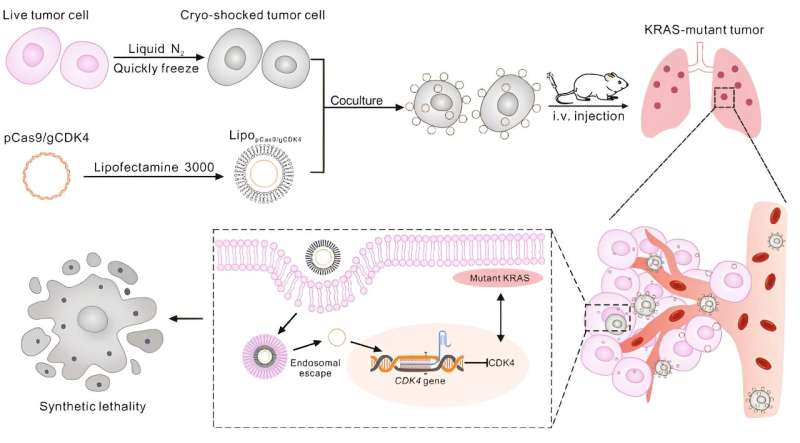April 1, 2024 report
This article has been reviewed according to Science X's editorial process and policies. Editors have highlighted the following attributes while ensuring the content's credibility:
fact-checked
peer-reviewed publication
trusted source
proofread
Using cryo-shocked tumor cells to fight lung cancer

A team of medical researchers at Zhejiang University, in China, has developed a way to use cryo-shocked tumor cells to fight lung cancer. In their study, published in the journal Science Advances, the group used fast liquid nitrogen treatment to modify tumor cells to carry gene-editing tools to fight tumors in mouse models.
As noted by the researchers, CRISPR-mediated genome editing tools and techniques hold great promise for treating cancer. However, problems with tumor targeting and off-target side effects hamper their effectiveness. For this new research, the team found a way to improve targeting by converting tumor cells into carriers for the gene editing tools.
The work involved cryo-shocking tumor cells extracted from a patient, which involved rapid freezing using liquid nitrogen. Such freezing removed their pathogenicity while preserving their structure, and more importantly, their surface receptor functions. After freezing, the CRISPR-Cas9 system was loaded into the cryo-shocked tumor cell, which made its way to the tumor, where it was ablated.
The team tested their approach by collecting tumor samples from lung cancer mouse models, cryo-shocking the samples, loading them with the CRISPR-Cas9 system and then injecting them back into the mice. The treated tumor cells made their way to the tumor as hoped, where they released the CRISPR-Cas9 system, which in turn knocked down cyclin-dependent kinase 4, resulting in tumor cell death.
In comparing the approach to simply injecting the CRISPR-Cas9 system into tumors, the research team found that the newer approach offered greater lethality. The improvement, they found, was due to greater accuracy in targeting. The deactivated tumor cells were drawn to the tumor, where they bonded with the active tumor cells via cell receptors, giving the gene editing system direct access to target cells. The approach also prevented the gene editing system from working on noncancerous cells.
The research team noted also that freezing cancer cells using liquid nitrogen allowed the cells to retain their antigens, which they suggest could prove useful in developing a vaccine as part of cancer treatment.
More information: Feng Liu et al, Cryo-shocked tumor cells deliver CRISPR-Cas9 for lung cancer regression by synthetic lethality, Science Advances (2024). DOI: 10.1126/sciadv.adk8264
© 2024 Science X Network



















